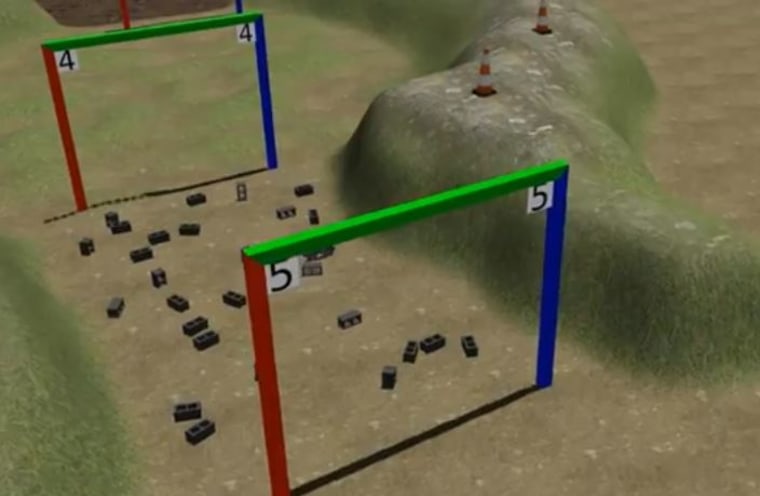Seven teams of software gurus whose code deftly controlled a virtual, human-like robot through a virtual obstacle course were awarded a real humanoid to program for a real-world competition to develop disaster response robots, the Pentagon's advanced research arm announced Thursday.
The teams competed in the virtual leg of a competition run by the Defense Advanced Research Projects Agency, known as DARPA, to develop machines that can operate with limited human supervision to assist in response to future natural and human-caused disasters.
These robots might be useful, for example, in situations such as shutting off reactors at a nuclear power plant battered by a massive earthquake and tsunami — thus avoiding the type of radiation leakage that occurred at Japan's Fukushima power plant in March 2011.
"During the first 24 hours, if it would've been possible to vent the reactors (using robots), the explosions would not have occurred and the disaster would have been much less severe," Gill Pratt, program manager for the DARPA Robotics Challenge, explained in a telephone briefing with reporters.
Technology, he said, is to the point where it's plausible to build robots that can flawlessly function in environments engineered for humans, use tools designed for humans and be operated by people who don't know much about robots.
"Overriding all of this is an assumption that communications between human beings and between human beings and the robot are very degraded" in a disaster, Pratt added, meaning the robots need to behave autonomously, responding only to simple commands such as: "open the door … go up the stairs."
The goal of the robotics challenge is to spur the innovation required to build the machines and write the software that runs them. The virtual leg provided 26 teams with top-notch software skills but lack of access to real robots a chance to compete.
Seven teams in the virtual challenge earned an Atlas humanoid robot from Boston Dynamics to use in real-world competitions to be held in December 2013 and 2014, where additional teams will compete with robots they built themselves. The grand prize is $2 million.
For the virtual challenge, teams were required to command their robot to get into a sport utility vehicle and drive it along a road; get out and walk over muddy, uneven and rubble-strewn terrain; and then connect a fire hose to spigot and turn the valve. Watch the video below to learn more.
The virtual simulation technology was built by the Open Source Robotics Foundation with DARPA funding, explained Brian Gerkey, the foundation's chief executive, who likened using the simulation to playing a video game.
"But we don't want the development to stop there," he said in the telephone briefing with reporters. "It is not just a game, it is a kind of game where if you come up with a winning solution for it, then the software that you have written should, for the most part, transfer to a physical robot in a physical environment and produce, qualitatively, the same result."

The simulation itself runs on so-called cloud computers, allowing participants to use "relatively modest" computers to run their software. To simulate disaster conditions, data communications were slowed and varying limits were put on the amount of bits allowed to be communicated at once.
Now that the competition is over, the open-source simulation software will be made available "to anyone in the world" for research, commercial applications, or anything else they might want to do with it, said Gerkey.
By the end of the robotics challenge in December 2014, Pratt said he expects an "evocative" demonstration of the technology and the beginning of a conversation about how best to deploy these machines.
How many machines the government will eventually order and where they will be housed is, for now, unknown. But it's possible that every mid-size town and larger could have one at its disposal to respond to natural or human-caused disasters, Pratt said.
"Our role here is bringing the technology to the point that that discussion is possible to have," he said.
The top nine teams in the competition are:
1. Team IHMC, Institute for Human and Machine Cognition, Pensacola, Fla. (52 points)
2. WPI Robotics Engineering C Squad (WRECS), Worcester Polytechnic Institute, Worcester,Mass. (39 points)
3. MIT, Massachusetts Institute of Technology, Cambridge, Mass. (34 points)
4. Team TRACLabs, TRACLabs, Inc., Webster, Texas (30 points)
5. JPL / UCSB / Caltech, Jet Propulsion Laboratory, Pasadena, Calif. (29 points)
6. TORC, TORC / TU Darmstadt / Virginia Tech, Blacksburg, Va. (27 points)
7. Team K, Japan (25 points)
8. TROOPER, Lockheed Martin, Cherry Hill, N.J. (24 points)
9. Case Western University, Cleveland, Ohio (23 points)
NASA's Jet Propulsion Laboratory team already has its own robot and decided to combine its efforts. As a result, this freed an Atlas robot and a share of JPL's funding for Lockheed Martin's TROOPER team. Additional DARPA funding will go to Team K and Case Western, who have combined their efforts, and will use an Atlas robot donated by Hong Kong University in the December 2013 competition.
John Roach is a contributing writer to NBC News. To learn more about him, visit his website.
